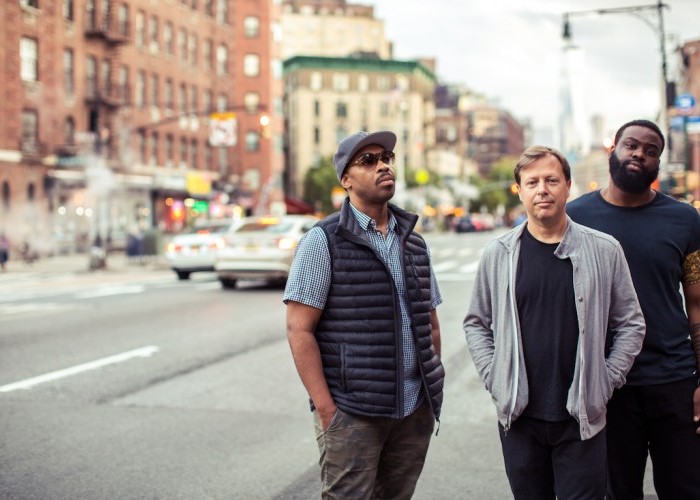Apr 2, 2024 12:59 PM
Saxophonist, Sonic Explorer Casey Benjamin Dies at 45
Casey Benjamin, the alto saxophonist, vocalist, keyboardist and producer who stamped his distinctive sounds on the…

Eric Harland (left), Chris Potter and James Francies have recorded a new album, Circuits.
(Photo: Dave Stapleton)Saxophonist Chris Potter’s new album, Circuits, simultaneously is a step forward and a return to earlier territory.
His first release on the Edition label, Circuits showcases some of the groove and r&b feel that marked Potter’s Underground group. With its miles-deep cybernetic synth bass and hissing, rattling hi-hat, “Green Pastures” sounds like it could be from an old Hank Crawford or Stanley Turrentine album on CTI.
“I guess for every project I do, I think about which aspects of my musical personality to bring out more, but a lot of it comes out on a subconscious level,” the bandleader said. “I grew up listening to Stevie Wonder and Earth, Wind & Fire, so it’s a big part of my musical perspective.”
The new trio that electrifies Circuits originally was assembled for a tour. Potter wanted to pursue an electric project, and brought in a longtime sparring partner, drummer Eric Harland, who in turn recommended pianist James Francies. The live shows went so well that the saxophonist decided a studio session was in order.
“The idea was to do some stuff in trio, which was one reason Eric mentioned [James], because he can really deal with playing the keyboard bass and soloing,” Potter explained. “It’s pretty remarkable. There’s not a lot of people that could really pull that off. It was at the rehearsal that I realized, ‘Wow, this guy really has something to say.’”
Francies’ contributions to Circuits often seem to come from the world of abstract electronic music. His synths add whooshes and ambient hum in addition to zapping, high-energy melody lines and the occasional bit of conventional pianistic playing.
“Chris is very hands-off,” Francies said. “He trusts my musical choices and intuition. I’ve worked with a lot of artists outside of the jazz world, so being able to bring those sonic ideas/elements and experiment even more was a lot of fun.”
The album—which also includes bassist Linley Marthe on four tracks—isn’t just about jamming with mics on. It’s tightly edited, and Potter overdubs multiple layers of reeds throughout, harmonizing with himself. He’s done that on other recordings, just not to the extent found on Circuits.
“It was always something I had to plan out pretty carefully ahead of time, because you only had two days in the studio,” Potter said. “But now, since I have a [recording] setup here at home that I can use, I was able to take my time and do as many takes and experiment with as many different things as I wanted.”
Led by Potter’s bass clarinet, the trio turns “Koutomé,” a tune originally by the Beninese group Orchestre Poly Rhythmo de Cotonou, into a slow, layered polyrhythmic journey. “I thought it was an interesting kind of groove,” Potter said, noting that the song originally was brought to his attention by guitarist Lionel Loueke, with whom he plays in bassist Dave Holland’s quartet Aziza. “It has that African two-against-three thing in there. But it’s a little bit different than some other music that I had heard, so I thought that would be a nice flavor to bring in.”
Circuits “didn’t seem like an ECM kind of project—[label head] Manfred Eicher and I both kind of agreed on that,” Potter continued, referring to the label on which he released the acclaimed 2017 The Dreamer Is The Dream. Potter was pleased that Edition, a British label with an international roster, embraced the recording and is striving to reach “the kind of audience that might appreciate it.”
Potter’s debut as a leader, Presenting Chris Potter (Criss Cross Jazz), was released in 1993. So, more than 25 years later, with a reputation as one of the most influential saxophonists of his generation, how does that early recording relate to his current work?
Potter replied: “Some things I hear and I go, ‘Yeah, that sounds a little young,’ and other things I hear and say, ‘Oh, that’s the same decision that I would make now.’” DB

Benjamin possessed a fluid, round sound on the alto saxophone, and he was often most recognizable by the layers of electronic effects that he put onto the instrument.
Apr 2, 2024 12:59 PM
Casey Benjamin, the alto saxophonist, vocalist, keyboardist and producer who stamped his distinctive sounds on the…

“He’s constructing intelligent musical sentences that connect seamlessly, which is the most important part of linear playing,” Charles McPherson said of alto saxophonist Sonny Red.
Feb 27, 2024 1:40 PM
“I might not have felt this way 30 to 40 years ago, but I’ve reached a point where I can hear value in what people…

Albert “Tootie” Heath (1935–2024) followed in the tradition of drummer Kenny Clarke, his idol.
Apr 5, 2024 10:28 AM
Albert “Tootie” Heath, a drummer of impeccable taste and time who was the youngest of three jazz-legend brothers…

“Both of us are quite grounded in the craft, the tradition and the harmonic sense,” Rosenwinkel said of his experience playing with Allen. “Yet I felt we shared something mystical as well.”
Mar 12, 2024 11:42 AM
“There are a few musicians you hear where, as somebody once said, the molecules in the room change. Geri was one of…

Henry Threadgill performs with Zooid at Big Ears in Knoxville, Tennessee.
Apr 9, 2024 11:30 AM
Big Ears, the annual four-day music celebration that first took place in 2009 in Knoxville, Tennessee, could well be…